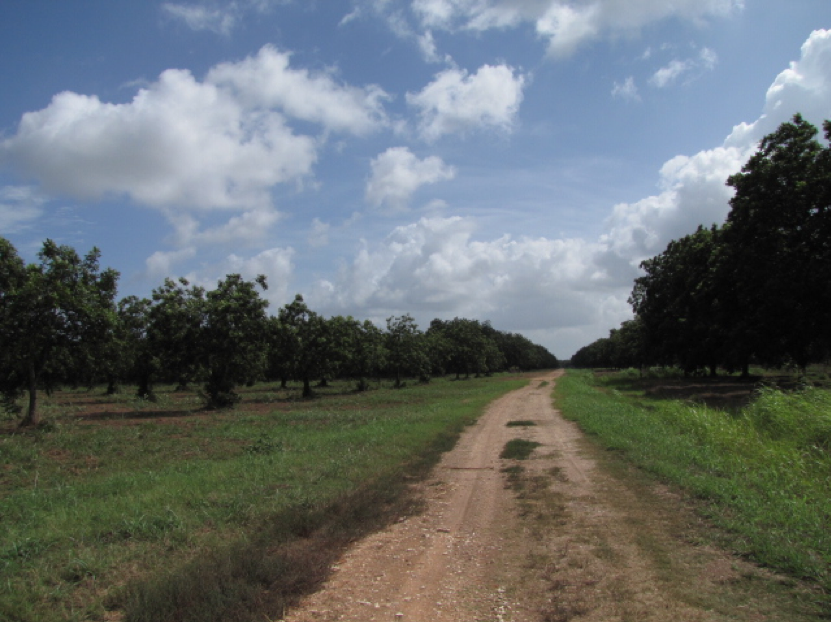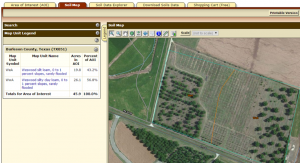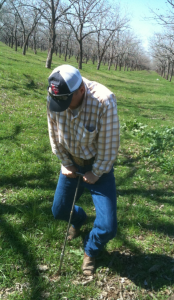Before You Plant, Evaluate Your Soil
Doing a pre-plant soil evaluation could mean the difference between a successful orchard and a failing one.

Soil type change (east side of road vs. west) in a Texas pecan orchard. (Photo by Monte Nesbitt)
Unfortunately, a successful outcome won’t happen for everybody that plants a pecan tree. Pecan trees have horticultural requirements that must be met. Many pecan trees planted in 2019 will fail to thrive because of misapplication of water (too little, too much, wrong time, or unsuitable quality). Some will succumb to the neglect of unchecked weed control or improper herbicide use. Yet others will be stunted from foliage feeding insects or borers that attack trees weakened by freeze injury growing on low-lying topography. And that’s just a few examples of how pecan orchards fail.
Pecan trees are resilient plants, and most of these establishment obstacles can be overcome with grower education. One obstacle that can defeat the most educated and experienced pecan growers is soil. Failure to identify soil limitations for pecan trees prior to planting is a major reason why many pecan trees planted in 2019 will not establish well, fail to thrive, lag in growth and development, and either never meet their potential for nut production or even die.
Soil is the literal foundation of a pecan orchard, but it is much more than a substrate for holding trees up or a surface for harvesting nuts. Soil is the mediator for root growth and health. It facilitates water uptake, exchanges vital gases with the atmosphere and provides access to nutrients that are essential to plant growth. Soil can be positively or negatively influenced in many ways by farming over time, but many of its natural properties are unchangeable, and replacing the soil on an orchard site to any appreciable depth is not feasible. The permanence of the soil and its long-term contributions to the success or failure of a pecan orchard, therefore, need to be considered very carefully.
A real-life story of pecan soil suitability is shown in the first picture. What appears to be two pecan orchards of different ages separated by a dirt road is, in fact, two blocks of a single pecan orchard planted the same year of the same variety and given the same care and management. The dirt road coincidentally delineates a soil type change at this site. Trees on the right are growing in a well-drained soil that imparts good gas exchange to roots and has moderate water and nutrient retention. Trees on the left are growing in a heavy clay soil with high water and nutrient holding capacity but low gas exchange. Heavy clay soils like this hold excess water for too long when irrigated and become anaerobic, depriving roots of oxygen and ultimately stunting tree growth and development. Mucky soil conditions also favor the growth of root rot fungi like Phytophthora and Armillaria that further exacerbate the lack of vigor. Healthy pecan roots are not susceptible to these opportunistic root rots, but pecan root health in heavy clay soil is compromised, increasing that susceptibility to root pathogens.
The long-lasting and negative economic consequences of an unsuitable soil can be avoided by thorough pre-plant soil evaluation. New and experienced growers alike who are expanding the frontiers of pecan planting with ten acres or a thousand acres should take steps to avoid planting pecan trees in an unsuitable soil—whether that be on all or part of the land under consideration. The following outline of soil evaluation steps can prevent lost income, lost time, and hard feelings among business partners, investors, and husbands and wives!

This Web Soil Survey custom soil report identifies two soil types on the Texas A&M University pecan orchard in College Station, Texas.
Step 1-The Web Soil Survey
The USDA Natural Resource Conservation Service provides a powerful head start to pre-plant soil evaluation through customizable soil maps that identify, classify, and describe soils and their important physical and chemical properties. This website, Web Soil Survey, replaced the old paperback soil maps that were published by NRCS for most U.S. counties. Today, any landowner considering planting a pecan tree should know the classification (name) of the soil on the site being considered, how many soil types exist on their site, and how they are spatially arranged. The Web Soil Survey allows users to identify a property by address, latitude-longitude, or sequential zooming. With the property boundaries visible, individuals create an area of interest (AOI) which then is merged with soil map information to create a customized soil map for the entire property.
Along with a customized and printable soil report that provides basic soil descriptors, the Soil Data Explorer function provides important insight to the physical and chemical properties of each soil in the AOI, such as pH, Cation Exchange Capacity (CEC), sodium adsorption ratio (SAR), water holding capacity, suitability for irrigated agriculture and more. Collectively, the Web Soil Survey is a powerful data collection that can help growers begin to understand whether they are considering an appropriate site for a pecan orchard or not.
Step 2—Verify the NRCS Map
The web soil survey map should be considered a starting point for understanding the soil diversity (or lack thereof) on the proposed orchard site. The soil testing and evaluation work that went into the original soil map’s creation dates back decades to more than a hundred years in some cases. While the data does not become obsolete as the years pass, the exact boundary lines within the mapping units can vary according to the resolution of sampling that was originally done. The map units deal with the major dominant soils and soil associations, rather than minor soils and complex soil associations in some areas. The following statement on the website’s introductory soils information should be noticed: “If intensive use of small areas is planned, however, onsite investigation is needed to define and locate the soils and miscellaneous areas.” A pecan orchard is very much an “intensive use,” so purposive collecting of soil samples within each map unit should be done to create a verified and updated soil map for the property. Pinpointing soil type changes on the property can be extremely beneficial for planning irrigation zones, fertilization strategies, and other management practices.
Step 3—Get Digging!
A lot can be learned by hand digging test holes for each soil type on the proposed orchard site. If the soil cannot be dug by hand to a depth of at least 3 feet due to the presence of rock or clay lenses, or because of equipment compaction, then is it fair to assume that tree roots may likewise struggle to explore that soil if it is not ameliorated? As soil bulk density increases, the ability of tiny feeder roots to penetrate and grow into it decreases. Digging of pits or trenches with a backhoe can be useful for observing the soil horizon changes and for more comprehensively evaluating textural changes from topsoil to subsoil, but hand digging holes provides important insight too.
Soil color is a useful field assessment that can be learned from digging pits or test holes. Vivid red to orange hues of color in the soil are indicators of iron oxidation. This coloration, even in clay soils, means that some oxygen is present. Brown color indicates good organic matter and complex soils with some silt particles and a loamy texture. Black soil color is often indicative of predominantly clay textured soil with high calcium content. Gray color with clay texture can indicate reduced amounts of oxygen, and bluish coloration typically is associated with clays having the poorest oxygenation.
When any presence of clay texture is found to be present, it is important to hand dig test holes to determine internal water drainage. The following test procedure is simple but effective. Dig a minimum of four representative holes for each soil type on the map with handheld post-hole diggers. Do not use an auger, which will skew the results by glazing the sidewalls of the holes. Holes should be dug 30 to 36 inches deep and 10 to 12 inches in diameter. Fill each hole full of water and evaluate how long it takes for the hole to drain water completely. Sites being considered for pecan production should drain in less than 24 hours. Deep sandy loams, ideal for pecan production, will likely drain in less than an hour. As clay content in the soil increases, drainage time likewise increases. Percolation test holes dug in 100 percent clay soils may not drain fully in 48 hours or longer. When that soil drainage problem exists, a pecan orchard may not survive at all if exposed to too much water. At the very least, trees can be expected to be stunted in growth and low-yielding throughout their life.
The highest rates of internal drainage will be on sandy soils, loamy sands, sandy loams, and sandy clay loams. Sand particles are inert, have no CEC, and thus, do not retain either water or minerals on them as clay and loam particles do. Although pecans thrive in deep, well-drained soils, fast rates of drainage from sand particles in the soil should alert the grower that irrigation and fertility inputs will need to be high throughout the commercial life of the orchard to support commercially viable levels of nut production.
Percolation tests for pecan orchards should be performed during average or normal soil moisture conditions. Performing this test on drought-affected soils may cause the results to be falsely skewed to the fast side. In such conditions, repeat the test two to three times to “charge” the soil with water and normalize the results.
Step 4—Lab Analyses
Growers who to this point have not identified a major limitation in the soil or soils on the property should collect soil samples for analysis by a soil testing laboratory. Most land-grant universities have a soil-testing lab that conducts nutritional analysis for a competitive fee. Land-grant labs do not sell fertilizer, so their results are not biased for that purpose. Good private labs exist too, including some that perform services for fertilizer and agricultural service providers. Samples should be collected with a soil collection tube, auger, coring device, or sharp billed shovel. Samples should be collected as a composite of approximately a dozen cores, or shovel slices, on each identified important soil classification on the property. Consult the lab to be used to learn what they prefer in soil volume for the particular tests being conducted and how they prefer that the soil be dried.
How deep should samples be taken? Routine samples collected in established orchards to assess how fertilizer practices are influencing soil fertility are recommended to be collected to a depth of 8 to 12 inches. It is this depth that the greatest preponderance of feeder roots are found, and it is also the depth of soil that is most influenced by fertilizers applied to an orchard floor that is not routinely plowed. For pre-plant evaluations of soil suitability, an analysis of the subsoil should also be performed at least once by sampling to a depth of 24 to 30 inches. Such sampling will more fully assess the soil’s chemical and nutritional influence on tree roots. Here again is where the Web Soil Survey may be useful. The Soil Data Explorer allows for assessment of chemical and physical properties at specific depths. By entering different depth ranges for chemical properties, it may find that a soil is homogeneous from 0 to 30 inches and a single sample is sufficient. It may also help growers adjust sampling depth to capture the existing variation between topsoil and subsoil.
Laboratory soil analysis provides important information about the suitability of the soil for pecan tree growth and production. Here is a breakdown of the findings that a grower should be seeking before planting trees.
Textural classification: Soil labs can verify the textural classification of a soil sample. It is a good idea to have this service performed for new orchard sites. It should be a verification step of the Web Soil Survey classification, but why not get a good second opinion? Much of the future growth and production of pecan trees will be tied to the textural classification of the soil in which it is growing.
Soil pH: Soil pH is a measure of acidity/alkalinity and the reactivity and availability of nutrients in the soil. At low pH, micronutrients like aluminum become toxic. At high pH, micronutrients like iron, zinc, and manganese become less available for root uptake, creating deficiencies. Pecan trees have a fairly wide tolerance for pH, and there are no rootstocks that have been identified specifically for the extremes, but the pH results in a soil test will bear out management practices that need to be undertaken for best growth. Soil reports having a pH below 6.0 will likely include a liming requirement to raise it appropriately. Pre-plant is the best time to address liming and many other soil amendments because it is the best opportunity to use a plow for deep incorporation.
Detailed Salinity: Pecan trees are sensitive to salt content and will not grow well in soils with a high electrical conductivity (EC), a high sodium adsorption ratio (SAR), or high content of certain salts like boron. New orchard sites in low rainfall environments, in areas where previous row crop farming may have increased soil salt presence or where the irrigation water is known or suspected to be either sodic (containing high levels of sodium) or saline (high in total salt content). It is really a low-cost investment for any new orchard site to ensure that salts are not a hidden problem on the site.
Once the EC, SAR and other salt levels have been determined, refer to state guides for recommended tolerable thresholds. Soil textural class has a bearing on how much salt or sodium is tolerated. Coarse-textured (sandy) soils are more effectively and easily leached, so a higher natural salt content can be tolerated. EC ranges greater than 1.0 and SAR values greater than 3.0 may signal a potential problem for pecan trees, depending on soil type, natural rainfall at the site and irrigation resources that are available.
Major and Minor Nutrient Levels: Part of the function of soil is to serve as a bank or repository of essential plant nutrients, supplying them steadily as needed to support annual growth and nut production. Laboratory analyses will deliver a report of the inherent deficiencies of those nutrients, thereby creating a picture of the fertilizer program that will be needed to support the growth of young trees and ultimately nut production of mature trees. Nutrient deficiencies in a soil are of themselves seldom a reason not to plant pecan trees because fertilizer can be added as a correction. Excessive levels of nutrients, however, can be toxic and a reason to think carefully about planting. Removal or neutralizing excess levels of phosphorus, boron, or other metals may not be possible. When the potential orchard site was previously farmed with other crops, used as a feedlot or in an oilfield, or served in other industrial waste application, it is important to know what potential nutrient toxicities could be present.
Organic Matter: An often overlooked but testable component in a soil analysis is the organic matter percentage in the soil. Organic matter generally has a positive influence on soil fertility, erosion, water holding capacity, and internal drainage and dispersion of water through the building of soil structure. Organic matter percentages in arable soils in the U.S. can vary widely from zero to greater than 10 percent, depending on many factors, such as rainfall, tillage, textural class, and past land use. While a low OM percentage—one percent or less—would not preclude pecans from being successful on the site, knowing that a soil has low OM provides the grower with knowledge of a factor that can be improved through amendments and planting of cover crops prior to planting and in the early life of the orchard.
A pecan orchard should be thought of as a long-term relationship with the land. The most permanent component of the land is the soil itself. Deep soil (3 feet or greater) of medium texture (loams, clay loams, sandy loams, etc.) that neither has too much or too little water-holding capacity, moderate nutrient retention along with a good organic matter percentage, and is neither saline or sodic will deliver good crops of pecans throughout the life of the orchard. Perfect pecan soil cannot always be found, and many less than perfect soils can support successful pecan orchards with the right management. Avoiding those serious, crop-limiting soil problems through pre-plant evaluation is worth the time and expense it takes to be certain that long-term relationship will be a rewarding one.


